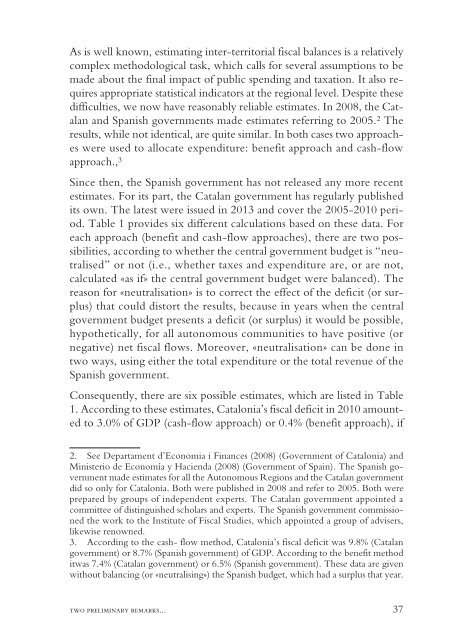The Economy of Catalonia
the_economy_of_catalonia._questions_and_answers_on_the_economic_impact_of_independence
the_economy_of_catalonia._questions_and_answers_on_the_economic_impact_of_independence
Create successful ePaper yourself
Turn your PDF publications into a flip-book with our unique Google optimized e-Paper software.
As is well known, estimating inter-territorial fiscal balances is a relatively<br />
complex methodological task, which calls for several assumptions to be<br />
made about the final impact <strong>of</strong> public spending and taxation. It also requires<br />
appropriate statistical indicators at the regional level. Despite these<br />
difficulties, we now have reasonably reliable estimates. In 2008, the Catalan<br />
and Spanish governments made estimates referring to 2005. 2 <strong>The</strong><br />
results, while not identical, are quite similar. In both cases two approaches<br />
were used to allocate expenditure: benefit approach and cash-flow<br />
approach., 3<br />
Since then, the Spanish government has not released any more recent<br />
estimates. For its part, the Catalan government has regularly published<br />
its own. <strong>The</strong> latest were issued in 2013 and cover the 2005-2010 period.<br />
Table 1 provides six different calculations based on these data. For<br />
each approach (benefit and cash-flow approaches), there are two possibilities,<br />
according to whether the central government budget is “neutralised”<br />
or not (i.e., whether taxes and expenditure are, or are not,<br />
calculated «as if» the central government budget were balanced). <strong>The</strong><br />
reason for «neutralisation» is to correct the effect <strong>of</strong> the deficit (or surplus)<br />
that could distort the results, because in years when the central<br />
government budget presents a deficit (or surplus) it would be possible,<br />
hypothetically, for all autonomous communities to have positive (or<br />
negative) net fiscal flows. Moreover, «neutralisation» can be done in<br />
two ways, using either the total expenditure or the total revenue <strong>of</strong> the<br />
Spanish government.<br />
Consequently, there are six possible estimates, which are listed in Table<br />
1. According to these estimates, <strong>Catalonia</strong>’s fiscal deficit in 2010 amounted<br />
to 3.0% <strong>of</strong> GDP (cash-flow approach) or 0.4% (benefit approach), if<br />
2. See Departament d’Economia i Finances (2008) (Government <strong>of</strong> <strong>Catalonia</strong>) and<br />
Ministerio de Economía y Hacienda (2008) (Government <strong>of</strong> Spain). <strong>The</strong> Spanish government<br />
made estimates for all the Autonomous Regions and the Catalan government<br />
did so only for <strong>Catalonia</strong>. Both were published in 2008 and refer to 2005. Both were<br />
prepared by groups <strong>of</strong> independent experts. <strong>The</strong> Catalan government appointed a<br />
committee <strong>of</strong> distinguished scholars and experts. <strong>The</strong> Spanish government commissioned<br />
the work to the Institute <strong>of</strong> Fiscal Studies, which appointed a group <strong>of</strong> advisers,<br />
likewise renowned.<br />
3. According to the cash- flow method, <strong>Catalonia</strong>’s fiscal deficit was 9.8% (Catalan<br />
government) or 8.7% (Spanish government) <strong>of</strong> GDP. According to the benefit method<br />
itwas 7.4% (Catalan government) or 6.5% (Spanish government). <strong>The</strong>se data are given<br />
without balancing (or «neutralising») the Spanish budget, which had a surplus that year.<br />
two preliminary remarks... 37


